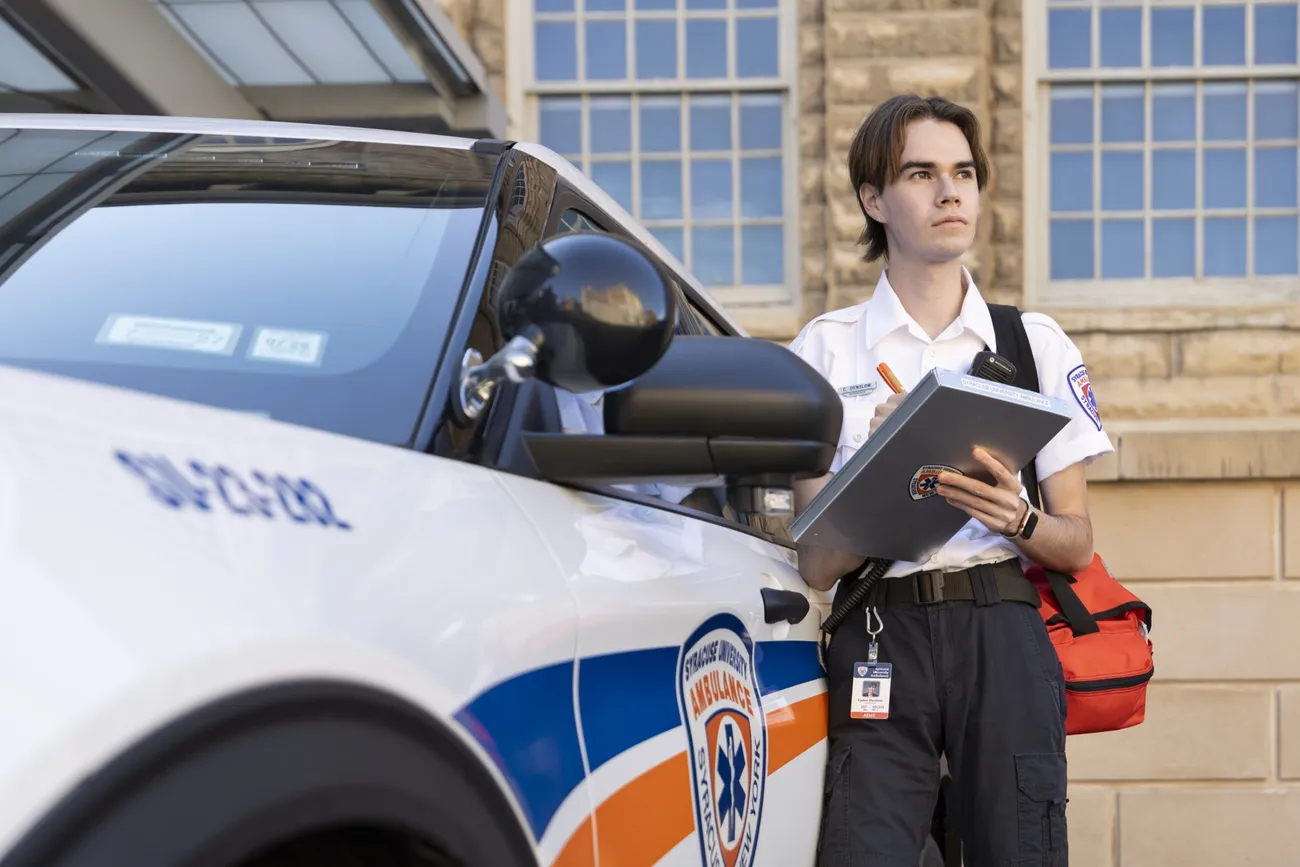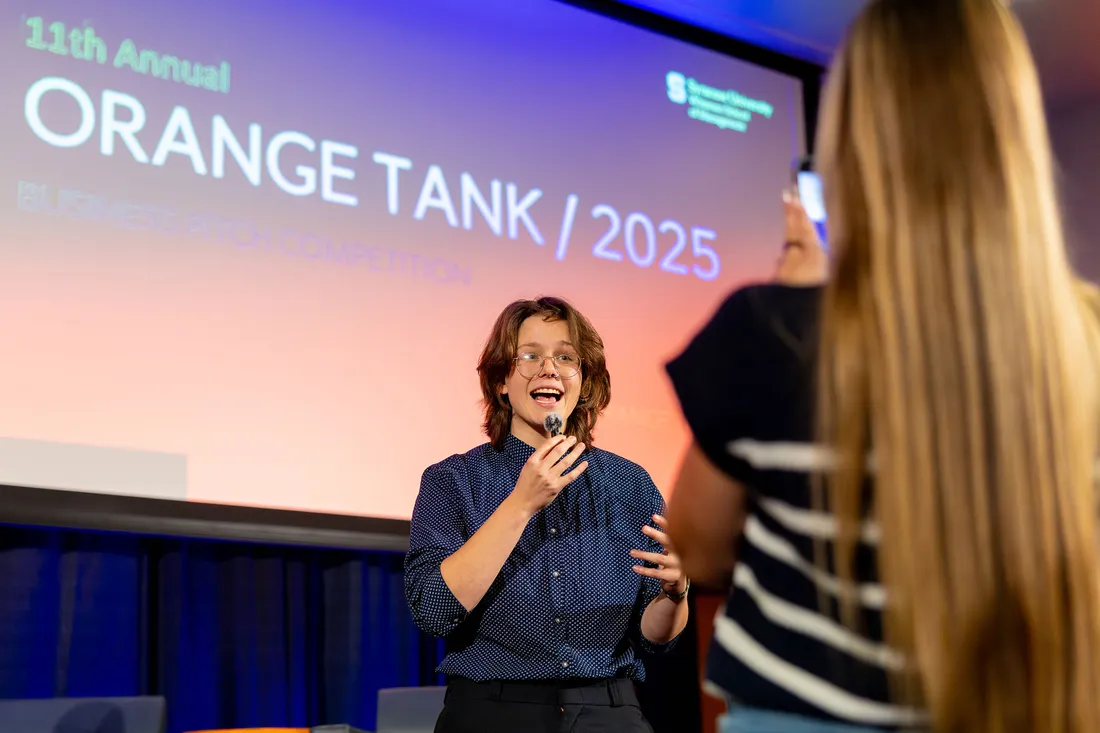When someone frantically waved down his ambulance, Caden Denslow ’25, G’26 only had seconds to react. His trainee driver pulled over and Denslow assessed the scene—the patient had a critical injury.
“We began life-saving measures and stabilized them enough to transport them rapidly to the hospital,” recalls Denslow, a Master of Social Work candidate and field supervisor for Syracuse University Ambulance (SUA).
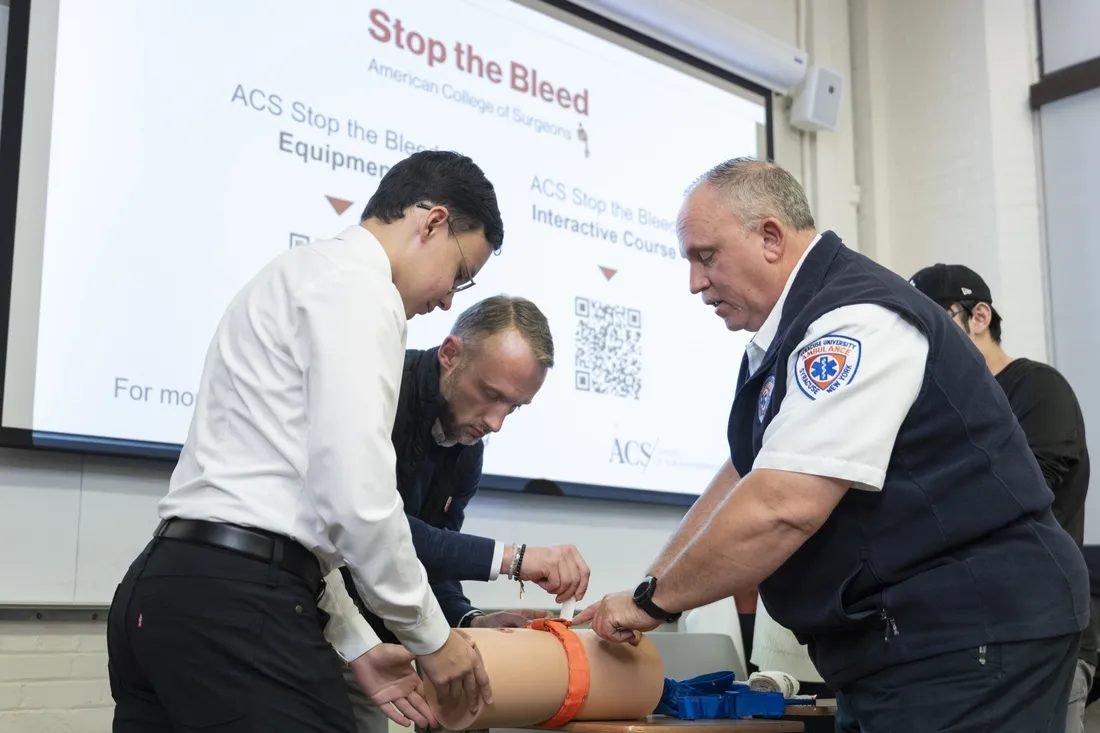
Paul Smyth (right) demonstrates life-saving techniques during a Stop the Bleed training for community members.
Later, the lead trauma surgeon called Paul Smyth, SUA’s manager of Emergency Medical Services (EMS), to let him know that Denslow’s prompt care directly contributed to the patient’s survival.
“Knowing that someone is alive because of our actions—it’s an incredible reminder that what we do really matters,” Denslow says.
For more than 50 years, Syracuse University Ambulance has served as both a vital safety resource and a powerful classroom for leadership, teamwork and personal growth. The student-run emergency medical service operates 24/7 during the academic year, responding to more than 1,500 medical emergencies annually. Whether answering calls in residence halls, covering football games at the JMA Wireless Dome or teaching life-saving training in the community, SUA members are at the center of high-stakes learning.
Training and Mentorship
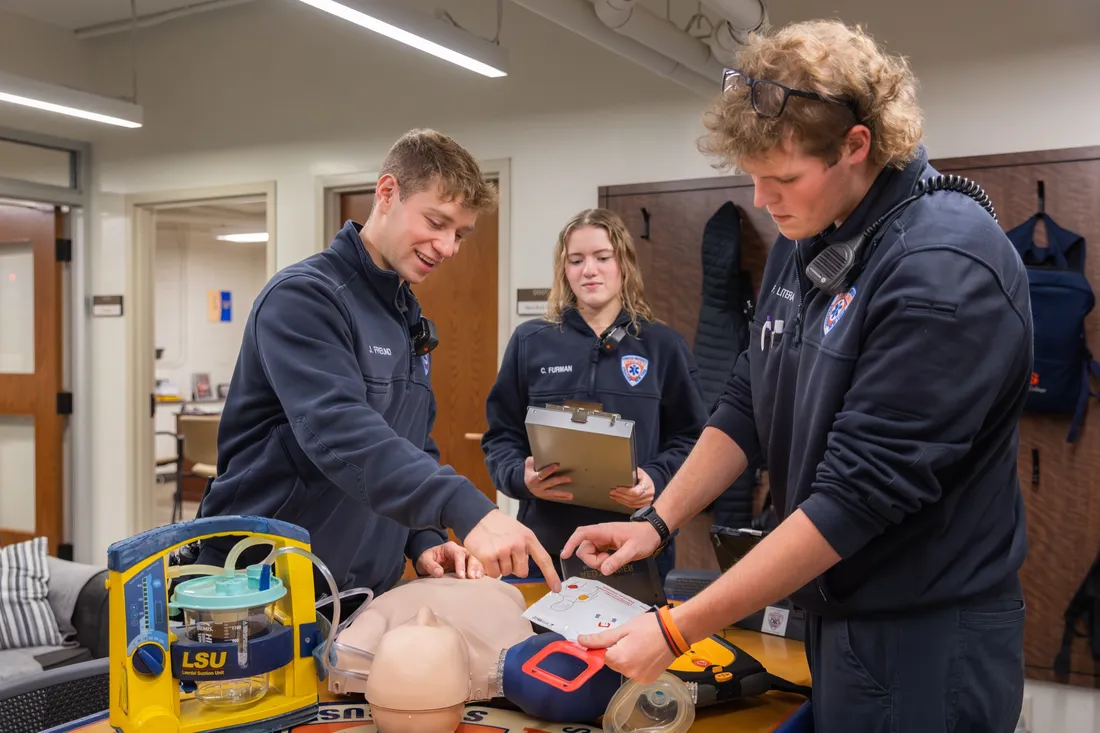
Personnel supervisor Jonah Freund ’26 (left) mentors newer members of Syracuse University Ambulance, guiding them through hands-on training.
Each semester, SUA selects 15-18 new members from over 200 applicants. The recruits come from all majors—most with no medical experience.
“We look for empathy, work ethic, willingness to learn and overall attitude,” says Jonah Freund ’26, a dual major in biotechnology and sociology who serves as a personnel supervisor. “Our goal is to give them the tools to provide the best patient care possible.”
New members begin with a six-week probationary phase that combines classroom instruction, hands-on training and ride-along shifts with assigned mentors. At the end of their first semester, recruits must pass skills and written exams before they can begin formal emergency medical technician (EMT) certification training. They then take EMT classes twice a week through American Medical Response of Central New York, on top of their academic courseload. This prepares them for the New York State EMT exam at the end of their second semester—making it nearly a full academic year before they’re certified.
Whether they go into medicine, law or business, the experiences here carry over. They learn to make quick decisions, communicate under pressure and take responsibility for others—skills that work in any career.
Paul Smyth
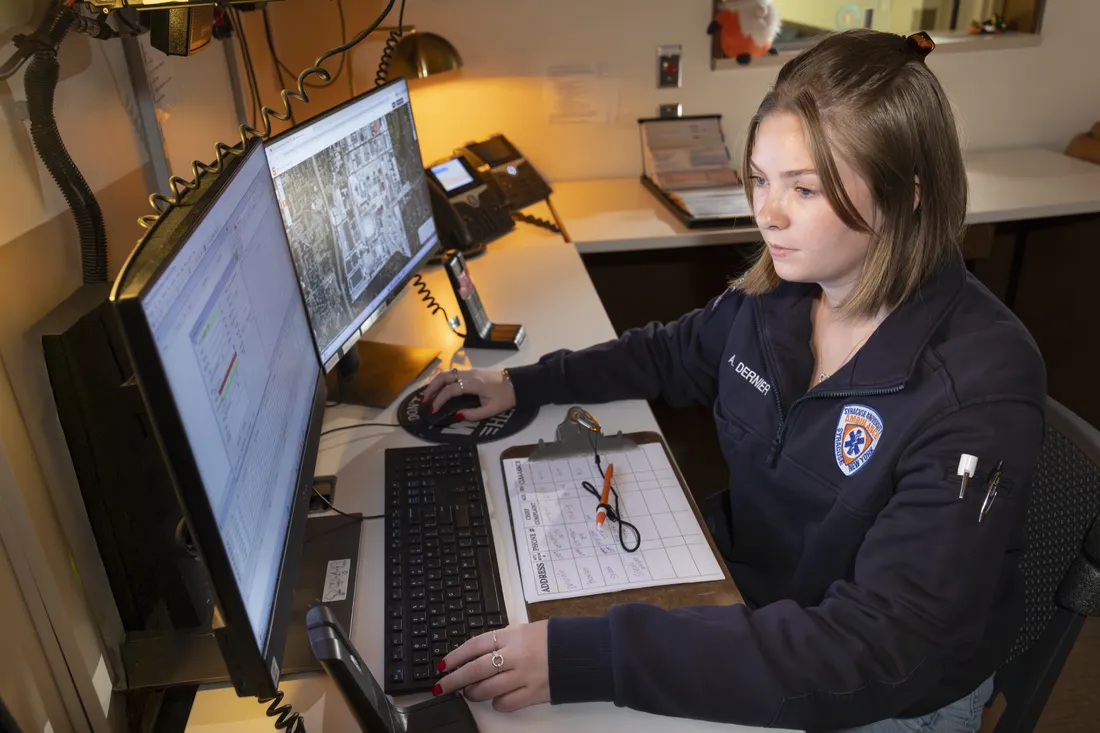
At the dispatch center, Abigail Dernier ’26 oversees communication and call coordination to ensure fast, effective emergency response.
“The process can feel overwhelming, especially since we’re all still students balancing classes, exams and personal life,” says Abigail Dernier ’26, a biology major and personnel supervisor. “Between the supervisors and their mentors, recruits always have someone to rely on.”
Once certified, members begin internal training to be ambulance drivers and crew chiefs—those that provide primary patient care. They can also become certified as dispatchers as well as seek out leadership positions.
“Becoming a driver was a fun challenge, but crew chief was toughest—learning to properly manage a scene and my crew led to tremendous personal growth,” Dernier says. “I’m also a dispatcher for SUA, a vital role that coordinates different agencies behind the scenes.”
Service and Community

New SUA members learn CPR as part of their training.
SUA’s mission extends far beyond 911 calls. Members regularly lead CPR and Stop the Bleed training for students, faculty and staff, and provide standby medical service at sporting events, concerts and festivals.
“First responders have very little control over the scenes they show up to. Standbys are like that but without the controlled environment of the ambulance,” Dernier explains. “It takes confidence and trust in your team members—and it’s often a bonding experience.”
The students also become much more than EMTs. “They’re learning to be community members,” says Smyth. “Service doesn’t stop when the call is over. It’s about making your environment safer and helping others be prepared.”
Skills That Transfer Anywhere
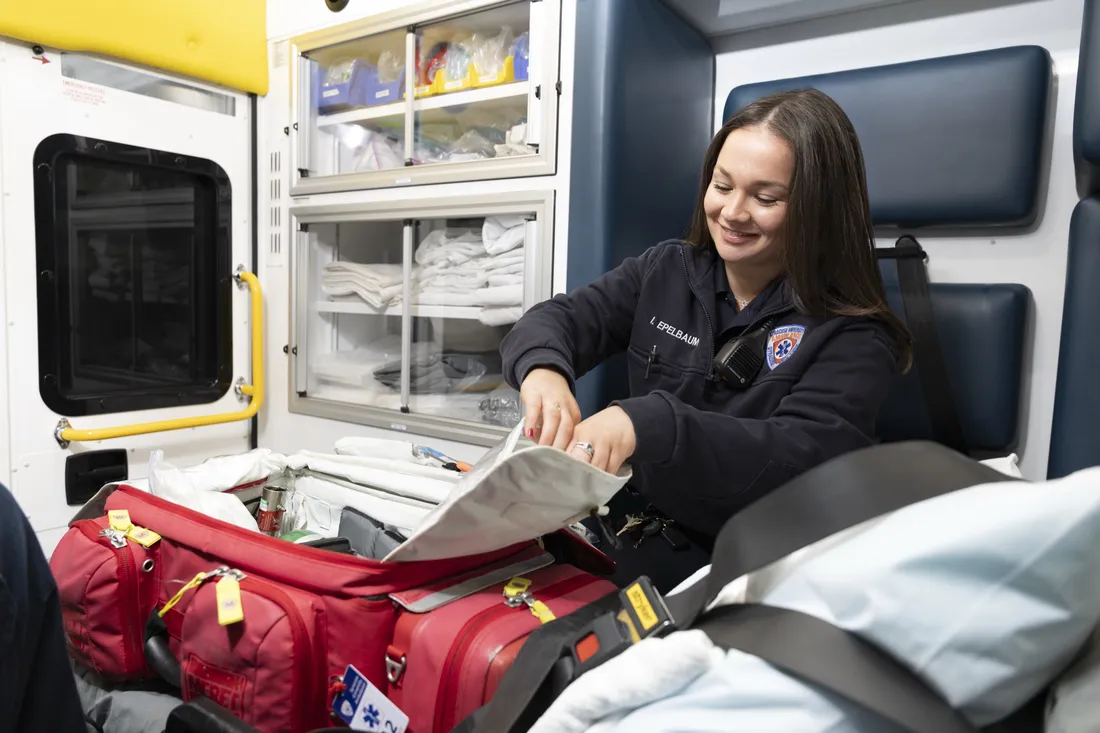
Isabelle Epelbaum ’27 checks and organizes medical gear to ensure her ambulance is ready for the next emergency call.
Smyth has watched countless students transform from nervous recruits to confident professionals. “Whether they go into medicine, law or business, the experiences here carry over,” he says. “They learn to make quick decisions, communicate under pressure and take responsibility for others—skills that work in any career.”
For Isabelle Epelbaum ’27, a biotechnology major who serves as a mentor and the organization’s public relations officer, SUA requires a unique combination of abilities. “Being a member is truly unlike any typical college experience,” she says. “The varied roles—working overnight shifts, dispatching calls, maintaining the organization’s public image—demand strategic and concise communication to ensure both operational integrity and public trust.”

Blending social work and emergency response, Caden Denslow ’25, G’26, applies interpersonal and crisis management skills to support patients and peers in the field.
The progression from learner to teacher is constant. “It’s a continuous evolution,” Smyth says. “There are always people just starting and others finishing their time here.”
Reflecting on her time with SUA, Dernier appreciates the collaborative spirit and relationships among members. “I’ll remember how we supported each other through personal challenges and the mentorship between members—friends, really,” says Dernier. “It’s the people that make the place.”
Denslow agrees. “No other organization affords students the opportunity to develop themselves socially and professionally to this level,” he says. “I’ve been challenged clinically, administratively and personally. The ability to calm myself, recognize the problem at hand and execute a solution—I’ve already applied that skill in many aspects of my life.”

